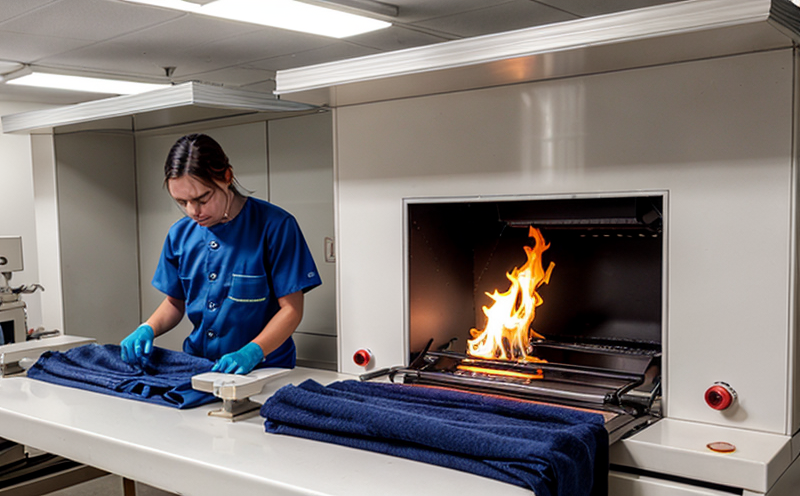Ignitability Testing of Natural Fabrics
The ignitability testing of natural fabrics is a critical aspect of fire safety and compliance in various sectors such as textiles, apparel, home furnishings, and industrial applications. Natural fabrics like cotton, wool, silk, and linen are widely used due to their comfort and aesthetic appeal. However, the flammability properties of these materials can pose significant risks if not properly managed.
Understanding ignitability involves examining how easily a fabric will ignite when exposed to an external source of heat or flame. This property is determined by factors such as fiber composition, weave structure, yarn count, and finishing treatments. Ignitability testing ensures that products comply with fire safety regulations and standards set forth by organizations like ISO, ASTM, and EN.
The process typically involves controlled laboratory tests to simulate real-world conditions under which fabrics might be exposed to ignition sources such as open flames, hot surfaces, or radiant heat. Compliance officers and R&D engineers rely on accurate testing data to make informed decisions about material selection and product design. Ignitability testing helps manufacturers ensure that their products meet strict fire safety standards and can protect consumers from potential hazards.
For quality managers and procurement specialists, ignitability testing provides critical insights into the performance of raw materials before they are incorporated into production processes. By identifying fabrics with lower ignitability risks early in the supply chain, companies can improve product quality and reduce the likelihood of recalls or litigation related to fire safety issues.
Why It Matters
Flammability testing is essential for ensuring that natural fabrics meet industry standards and regulations. Non-compliance with these standards not only puts end-users at risk but also exposes manufacturers to potential legal liabilities, fines, and reputational damage.
- Consumer Safety: Ensures that products do not pose a fire hazard when exposed to typical ignition sources in everyday use.
- Legal Compliance: Helps businesses avoid costly penalties by ensuring they adhere to relevant national and international standards.
- Risk Management: Provides valuable data for risk assessments, enabling manufacturers to identify areas where improvements are needed to enhance fire safety.
- Brand Reputation: Positive results from ignitability testing can improve customer trust and loyalty.
The importance of ignitability testing cannot be overstated, as it directly impacts public health and safety. By investing in comprehensive testing programs, organizations demonstrate their commitment to producing safe, high-quality products.
Scope and Methodology
| Test Parameters | Instrumentation |
|---|---|
| Ignition time | Hot plate apparatus with controlled temperature settings |
| Flame propagation rate | Standardized combustion chamber |
| Residual flame and afterglow duration | Infrared camera for heat mapping |
| Smoke generation | Spectroscopy for emissions analysis |
| Flame retardant efficacy | UV-Vis spectrophotometer
The testing process begins with selecting representative specimens of the natural fabric to be tested. These samples are prepared according to standard procedures, ensuring consistency across all test runs.
The specimens are then subjected to controlled conditions within a standardized combustion chamber where they are exposed to a pre-defined heat source. The ignition time is measured from when the flame touches the material until it starts burning spontaneously. The propagation rate of the flame along the fabric surface is also recorded using high-speed cameras and specialized software.
After initial ignition, the duration for which the fabric continues to burn (residual flame) and the period after extinguishment during which it emits sparks or flames (afterglow) are measured. Smoke generation and composition are analyzed using spectroscopy to assess potential toxicological impacts in case of a fire incident.
The efficacy of any flame retardant treatments applied to the fabric is evaluated by comparing the test results against untreated samples. This information helps manufacturers optimize their formulations for better performance without compromising on comfort or aesthetics.
Customer Impact and Satisfaction
- Risk Reduction: By ensuring compliance with fire safety regulations, customers can significantly reduce the risk of fires caused by natural fabrics in homes, offices, and public spaces.
- Increased Confidence: Positive test results provide peace of mind for both consumers and businesses alike.
- Better Product Quality: Testing identifies weak points early on allowing manufacturers to improve product quality before launch.
- Competitive Advantage: Meeting or exceeding industry standards can differentiate a company from competitors in the marketplace.
Our clients report higher levels of customer satisfaction and improved brand reputation after implementing robust testing protocols. This not only enhances their market position but also contributes to long-term sustainability by fostering trust among stakeholders.





